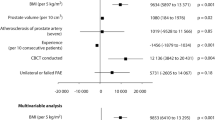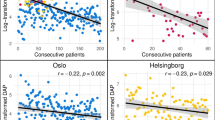Abstract
Purpose
To determine the range of radiation dose metrics for uterine artery embolization and the impact of patient and procedure factors on those measures.
Materials and Methods
Procedure records of 515 uterine embolization procedures were reviewed and various metrics recorded, including patient demographics, body mass index (BMI), radiation exposure measures and procedure-related details. Descriptive statistics were used to summarize the measures, and appropriate parametric and nonparametric tests were used to compare and assess the correlation between the measures and the cumulative dose (CD), dose area product and fluoroscopy time (FT). Multivariable regression analysis was used to assess the impact of individual factors on the measures of radiation dose.
Results
The strongest correlation among the measures compared were between CD and BMI (r = 0.70), while the correlation between BMI and FT was weak (r = 0.23). Dose was higher for those procedures done with aortography and those who had TAGM as the embolic agent. Multivariable analysis demonstrated an increase of 7.4% in CD for each increase in BMI, 5.9% for each increase in cm uterine length. FT was impacted to a lesser extent, with an increase of 2.8% per unit BMI. Increasing procedure time had a greater impact on FT (r = 0.56) than on CD (r = 0.33).
Conclusion
Among the measured variables, BMI had the greatest impact on CD and has a substantial impact on the risk of radiation-induced skin injury, even without prolonged FT.

Similar content being viewed by others
References
van der Kooij SM, Bipat S, Hehenkamp WJ, Ankum WM, Reekers JA. Uterine artery embolization versus surgery in the treatment of symptomatic fibroids: a systematic review and metaanalysis. Am J Obstet Gynecol. 2011;205(4):317 e1–18.
Miller DL, Balter S, Noonan PT, Georgia JD. Minimizing radiation-induced skin injury in interventional radiology procedures. Radiology. 2002;225(2):329–36.
Andrews RT, Brown PH. Uterine arterial embolization: factors influencing patient radiation exposure. Radiology. 2000;217(3):713–22.
Nikolic B, Spies JB, Lundsten MJ, Abbara S. Patient radiation dose associated with uterine artery embolization. Radiology. 2000;214(1):121–5.
Scheurig-Muenkler C, Powerski MJ, Mueller JC, Kroencke TJ. Radiation exposure during uterine artery embolization: effective measures to minimize dose to the patient. Cardiovasc Interv Radiol. 2015;38(3):613–22.
Miller DL, Balter S, Cole PE, Lu HT, Schueler BA, Geisinger M, et al. Radiation doses in interventional radiology procedures: the RAD-IR study: part I: overall measures of dose. J Vasc Interv Radiol. 2003;14(6):711–27.
Nikolic B, Spies J, Lundsten M, Abbara S. Patient radiation dose associated with uterine artery embolization. Radiology. 2000;214:121–5.
Nikolic B, Abbara S, Levy E, Imaoka I, Lundsten ML, Jha RC, et al. Influence of radiographic technique and equipment on absorbed ovarian dose associated with uterine artery embolization. J Vasc Interv Radiol. 2000;11(9):1173–8.
Nikolic B, Spies JB, Campbell L, Walsh SM, Abbara S, Lundsten MJ. Uterine artery embolization: reduced radiation with refined technique. J Vasc Interv Radiol. 2001;12(1):39–44.
Andrews R, Brown P. Uterine arterial embolization: factors influencing patient radiation exposure. Radiology. 2000;217:713–22.
Shah A, Das P, Subkovas E, Buch AN, Rees M, Bellamy C. Radiation dose during coronary angiogram: relation to body mass index. Heart Lung Circ. 2015;24(1):21–5.
Ector J, Dragusin O, Adriaenssens B, Huybrechts W, Willems R, Ector H, et al. Obesity is a major determinant of radiation dose in patients undergoing pulmonary vein isolation for atrial fibrillation. J Am Coll Cardiol. 2007;50(3):234–42.
Spies JB, Allison S, Flick P, McCullough M, Sterbis K, Cramp M, et al. Polyvinyl alcohol particles and tris-acryl gelatin microspheres for uterine artery embolization for leiomyomas: results of a randomized comparative study. J Vasc Interv Radiol. 2004;15(8):793–800.
Balter S, Hopewell JW, Miller DL, Wagner LK, Zelefsky MJ. Fluoroscopically guided interventional procedures: a review of radiation effects on patients’ skin and hair. Radiology. 2010;254(2):326–41.
Costantino M, Lee J, McCullough M, Nsouli-Maktabi H, Spies JB. Bilateral versus unilateral femoral access for uterine artery embolization: results of a randomized comparative trial. J Vasc Interv Radiol JVIR. 2010;21(6):829–35 (quiz 35).
Funding
This study was not supported by any funding.
Author information
Authors and Affiliations
Corresponding author
Ethics declarations
Conflict of interest
Author James B. Spies is a consultant for Le Force Group.
Ethical Approval
For this type of study formal consent is not required.
Informed Consent
This study has obtained IRB approval and the need for informed consent was waived.
Consent for Publication
For this type of study consent for publication is not required.
Additional information
Publisher's Note
Springer Nature remains neutral with regard to jurisdictional claims in published maps and institutional affiliations.
Rights and permissions
About this article
Cite this article
Lacayo, E.A., Khera, S.S. & Spies, J.B. Impact of Patient and Procedure-Related Factors on Radiation Exposure from Uterine Artery Embolization. Cardiovasc Intervent Radiol 43, 120–126 (2020). https://doi.org/10.1007/s00270-019-02321-7
Received:
Accepted:
Published:
Issue Date:
DOI: https://doi.org/10.1007/s00270-019-02321-7




